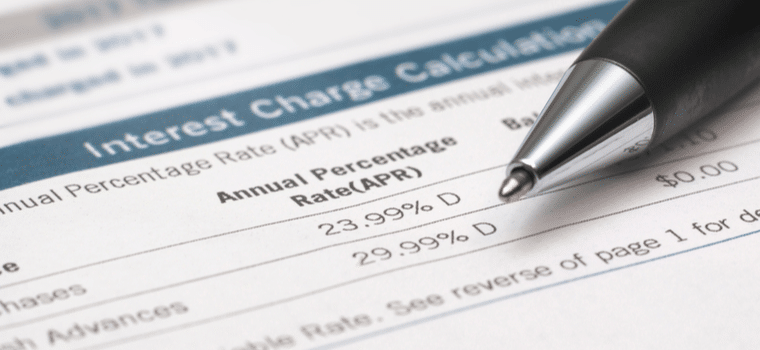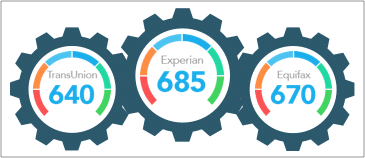The answer to the question, “What is a good APR for a credit card?” is relative. What one person may consider a good APR might not be satisfactory to another. Factors such as the issuing bank, applicant credit history and how the card will be used all have a bearing on the annual percentage rate offered.
A Good APR
In the second quarter of 2019, the national average APR for all credit cards was 17.68%. Low-interest credit cards registered an average APR of 14.69%, whereas bad credit offerings registered an average APR of 25.33%.
Not everyone will be in agreement about what equals a good APR. For example, someone with good, but not great credit might be satisfied with an APR that’s lower than the national average of 17.68%. Someone with an excellent credit score and impeccable credit history, however, may consider that APR unsatisfactory.
Different Types of APRs
- Introductory/Promotional – Some cards feature an introductory APR, such as 0% on purchases or balance transfers, that lasts from a few months to a year or more. If you don’t pay off the balance before the introductory rate expires, however, the regular rate will usually apply to the balance and result in you owing more money.
- Regular – Regular rates are offered in a range of variable — and sometimes fixed — APRs. Credit card issuers will consider factors, such as your credit history and score to determine what type of regular rate to offer you. In general, consumers with great or excellent credit will receive the best rates.
- Cash Advance – APRs for cash advances are typically higher, plus interest accrues immediately — without a grace period.
- Penalty – Payments that are considered 60-days delinquent can result in your creditor assessing a penalty APR. The penalty rate, which can be as steep as 29.99%, applies to both your current balance and any future purchases.
What Determines a Credit Card’s APR?
Different factors determine the APR offered by credit card issuers. Here are some to consider.
1. Current Prime Interest Rates
Most credit card issuers charge variable interest rates, which fluctuate according to the prime rate. The prime rate is what banks charge customers who have the best credit rating. The prime rate hovers approximately three points above the federal funds rate. When the federal funds rate increases, so does the prime rate, which, in turn, can increase your credit card’s APR.
2. Bank vs. Credit Union Issuer
Another factor that may affect a credit card’s APR is whether the issuer is a bank or credit union. According to S&P Global Market Intelligence, the average rate for a classic credit card from a credit union was 11.82 in March 2019, which is much lower than the average APR quoted by the Federal Reserve.
3. Credit Score
Both your credit score and the type of credit card also affect the APR. In general, the higher your credit score, the less of a risk you pose to creditors. Here’s a breakdown of how VantageScore rates credit scores:
- 810 – 850 = EXCELLENT
- 750 – 809 = GREAT
- 670 – 749 = GOOD
- 560 – 669 = FAIR
- 500 – 559 = POOR
- 300 – 499 = VERY POOR
Applicants who have great or excellent credit scores can typically qualify for the best APRs. Applicants with fair or poor credit scores, however, may often only be eligible for higher APRs or have their application denied altogether.
4. Credit History
Credit card issuers not only consider your credit score, but they also evaluate the information on your credit report to determine any risk factors. Poor payment history, collections activity and an excessive debt load relative to your income can all result in creditors issuing a higher APR.
5. Type of Credit Card
Credit card issuers may have a single APR that they assign to all approved cardholders. Or they may offer different APRs to cardholders who are approved for the same product. A cardholder that offers different APRs may base the APR on your credit score and history.
Credit cards that typically carry the highest rates are branded store cards, which can only be used at a particular retail location. Credit cards that are designed for people with bad credit also carry higher APRs due to a higher risk for the lender.
Rewards and balance transfer credit cards often require a score of 700 or better to qualify, with some having a higher minimum requirement of 750.
With a credit score of 700+, you can expect an APR on a rewards or balance transfer card to fall anywhere from 14.24%, which is below the average rate quoted by the Federal Reserve, to 26.24% or higher, which is way above average.
If you qualify for a rewards card with a credit score of 640, the APR offered may not be as attractive as it would be with a 700 or better score. For example, instead of starting at a below-average rate, the beginning APR could be over 20%.
6. Type of Transactions
APRs can also vary depending on whether you’re making a purchase, transferring a balance or withdrawing a cash advance. Some card issuers also assess a penalty APR for late payments. You can find out about a card’s APRs within the details of its terms and conditions.
Where to Find a Credit Card’s APR
Credit card companies are required by the Truth in Lending Act to provide a standardized source of information detailing each credit card’s APR and fees. The Schumer box is the industry standard. You can find the Schumer box within the credit card’s advertising page or within the online or paper application when applying for the card.
Why Does APR Matter?
The APR tied to your credit card matters because it determines how much you’ll pay for carrying a balance. The higher your credit card’s APR, the more money you’ll end up paying over time.
For example, if you have a credit card that has a $5,000 balance with a 14.24% APR, you’ll pay $58.52 per month in interest. If you have a credit card with a balance of $5,000 and an APR of 26.24%, however, you’ll pay much more — $107.83 per month in interest. Over time, interest can add up to hundreds or even thousands of extra dollars you’ll have to pay.
Getting a Low APR on a Credit Card
When you carry a balance, the lower the APR on your credit card, the more money you’ll save. If your current credit card has an APR that’s higher than what you’d like or you want to get the best rate possible, you have options.
1. Ask for a Better Rate
If your credit score is as good or better than when you originally opened the account and you’ve made all of your payments on time, consider calling your creditor and asking for a better APR. When you ask, mention your good payment history and credit score.
2. Apply for a Card With a Better Rate
If your creditor refuses to give you a better rate, you may want to apply for a different card featuring a more attractive rate. There are low-interest credit cards available and even some that offer 0% promotional financing on balance transfers.
A 0% balance-transfer card could potentially allow you to pay off your existing debt interest-free, less any balance transfer fees that may apply.
3. Shop Credit Unions
Compare credit card offers from credit unions. These not-for-profit organizations are often able to save their members money in the form of low fees and better interest rates. To join, you will have to meet the credit union’s qualifications, which may be as simple as paying a small membership fee or living or working in a certain area.
Keeping Interest Costs to a Minimum
Carrying a balance often results in interest charges, which adds more expense to your budget — especially if your credit card carries a high APR. To completely avoid interest charges, you can choose to pay off your balance each month within the grace period.
If paying off your balance isn’t an option, you can set up alerts to remind you to make on-time payments. Missing payments can be expensive. Even if you miss your payment by one day, you could get hit with a late fee totaling between $25 and $35, as well as monthly interest.
If you allow your payments to become 60-days delinquent, your creditor may assess a penalty APR to your current and future purchases, which can stay in effect indefinitely.
Credit Awareness
Monitoring your credit is a good way to stay aware of any changes to your credit report or score that may occur and possibly affect the APR on your credit cards. A product, such as ScoreSense, can help you by providing you with credit reports and scores from all three credit bureaus, as well as daily alerts and monthly updates.
If you’re not already monitoring your credit, what’s stopping you from taking action? Let us know in the comments.




